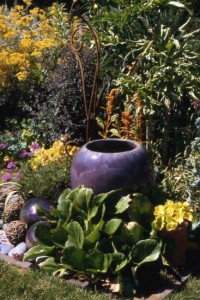New Trends in Container Design
You can grow just about anything in a pot!
Top 10 container creations from the region’s best garden designers. Whether filled with plants or used for pure ornamentation, containers are an important design element to the artful landscape.
 Why grow a container garden?
Why grow a container garden?
Move structure above soil level (move beauty closer to eye level)
Accessibility: lettuce grows great in pots!
Defines a focal point (a curve in the staircase, a bend in the path)
Provides natural perimeter (deck or patio)
Movement/flexibility (“Plants on Wheels”)
Enhance strengths and mask weaknesses of the garden
Showcase great plants
• Singular sensations (ie purple fountain grass or Japanese hako grass)
• Similar plants (ie coleus or sedums)
• Continual color (instant gratification)
• Make pots do what the rest of your garden won’t! (ie, lilies of the valley)
• Don’t forget the artistry of pots: show off your style!
Design Elements:
Tall focal element: Ilex ‘Sky Sentry,’ trellis element w/vine, grasses
Mid-range plants for texture, color and foliage
Trailing plants to soften edges
General guidelines and Planting Tips for Great Containers:
Plant “mix” should be 70% structural plants or perennials + 30% seasonal plants. Seasonal plants don’t necessarily have to be annuals, but bulbs, tender perennials (begonias, fuchsias) or herbs.
For best variety, design your container with a specific season in mind: Early Spring, Summer, Fall/Winter are good ones to shoot for. Don’t let your pots go dormant in the winter. Add something for interest even it it’s an ornamental “rust” art piece, berries/twigs, a bird nest, etc.
To lighten the load, especially of a large pot, fill 1/3 of your pot with Styrofoam peanuts OR I like to use upside down black plastic pots (we all have lots of those!). Gravel is too heavy.
Soil recipe: 1/3 planting compost + 2/3 fresh good-quality potting soil. When replanting seasonally, refresh soil with more planting compost.
General guidelines and Planting Tips for Great Containers (continued)
When renovating an old pot, start over with all new soil. If you’re working with very large pots and it’s impossible to remove all the soil, check for problem signs on existing plants. If everything looks healthy, just remove the top 1/3 of soil and replace w/above mixture . . . and plant away!
When your pot is in full sun or you can’t water often, use a soil polymer in the mix for water retention.
STUFF the pot, ignoring the “mature size” on the plant label. There will be plenty of soil for your crowded plants, and since they are regularly fertilized, they’ll be fine. Otherwise, you’ll have lonely-looking plants for the first _ of the season.
Watch out for dark-colored pots in full sun. They’ll bake your plants.
It’s okay to mix some sun plants with shade plants if you don’t care about blooms. If you have great leaf texture and color, they can make for a winning design.
Each time you water (usually daily during hot months) use _-strength water soluble fertilizer like Peters Professional or Miracle-Gro. Osmocote time-release needs 60ºF temperatures to release plant food, which we don’t get much of the year!
Deadhead frequently and watch for pests.
Never use predictable plants when you can choose from so many other varieties (ie use fancy-leafed geraniums instead of plain-old green ones)
Do use great plants for long-term interest and variety. Here are some ideas:
• Unusual annuals, like the new Million Bells petunias
• Variegated, sunset and lavender forms of Bacopa
• Helichrysum ‘Limelight’
• Salpiglossis (painted tongue)
• Anagallis ‘Skylover’
• Bright-leafed geraniums (Mrs. Quilter or Vancouver)
• Euphorbia myrsinites (donkey tail)
• Carex buchananii ‘Viridis,’ C. elata ‘Aurea,’ C. ‘Ice Dancer’
• Salvia patens (Gentian sage)
• Cerinthe major ‘Kiwi Blue’ or ‘Purpurascens’
• Muehlenbeckia complexa (wire vine)
• Veronica ‘Georgia Blue’
• Geranium ‘Ann Folkhard’
• Fuchsia ‘Firecracker’








